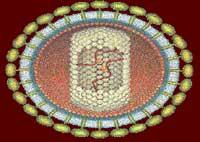Vaccine against AIDS: good news yes, but...
Initial vaccines, as well as conventional vaccines, aimed at producing antibodies that would protect against a subsequent infection. To do this, vaccines were made formed by superficial proteins of HIV, so that the immune system made antibodies against these proteins, hoping that later the body would be protected against the whole virus. But HIV showed that it is able to hide the target proteins of antibodies. In addition, it evolves very quickly and in a short time, superficial variants with other proteins are produced.

For this reason, the studies of recent years have been aimed at the realization of vaccines with a behavior similar to the immune system. For example, researchers at Merck laboratories introduced the DNA of the monkeys AIDS virus (SIV) on the HIV surface. At first, the vaccine with this virus (SHIV) gave very good results in monkeys: After 40 days, the number of viruses in the vaccinated monkeys was so small that it could not be detected. On the contrary, 13 of the 14 monkeys in the control group developed the disease. Undoubtedly, it was the best result ever obtained.
However, a team of researchers at the Harvard Medical School has tested a similar vaccine, and say the vaccine is not as effective as was originally thought because over time the virus was mutating. 7 of the 8 monkeys embedded by them lived after two years. However, the eighth, after 6 months, died. It seems that the mutation of a specific SHIV gene was enough for T cells in the monkey's immune system to lose the ability to know the SHIV virus.
According to Merck researchers, to get an effective vaccine it is necessary to increase the number of proteins that T cells can know. Thus, despite a mutation, T cells would look for other proteins as it is very difficult for all proteins to move at the same time.
On the other hand, the sessions have been carried out in the monkeys and until it is not tested can not be known if they are going to give the same results in humans.
In the magazine Elhuyar Zientzia eta Teknika, number 171, December 2001, you can find all the information on this topic.
Buletina
Bidali zure helbide elektronikoa eta jaso asteroko buletina zure sarrera-ontzian











